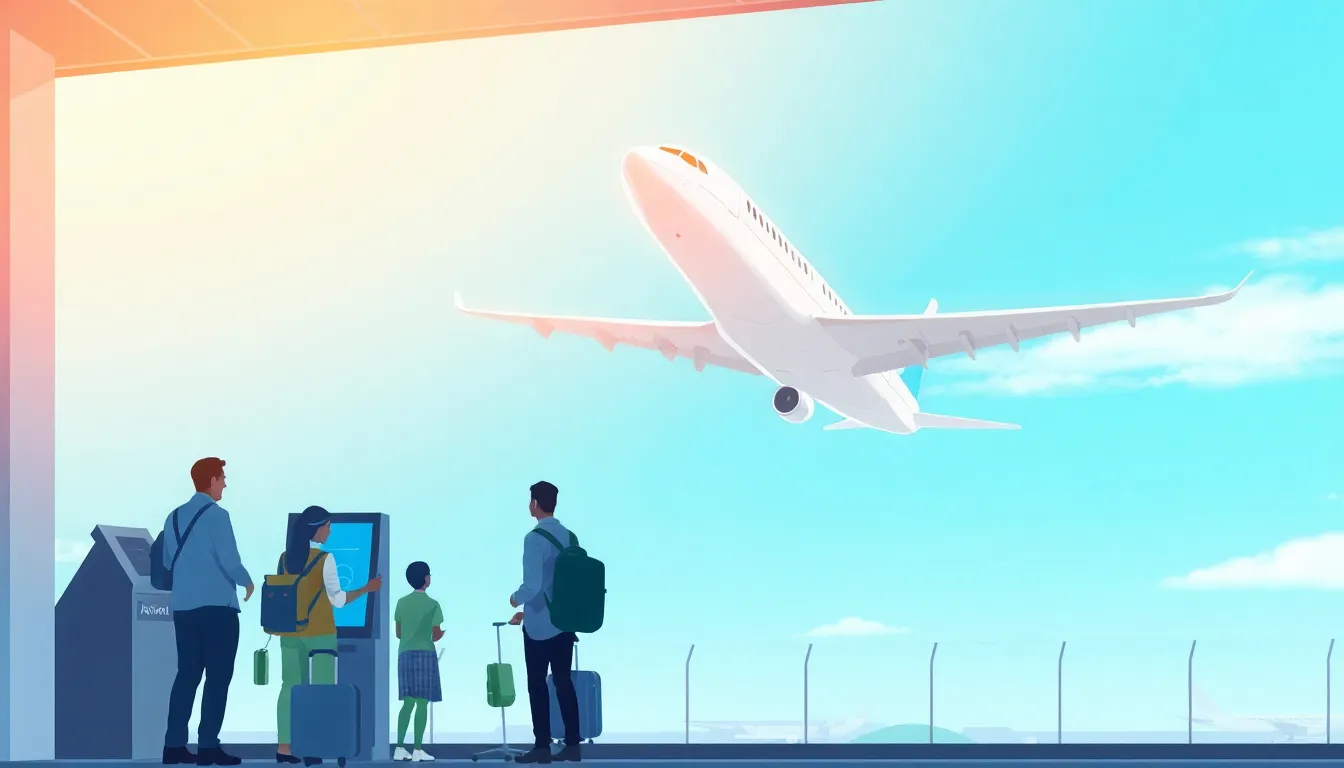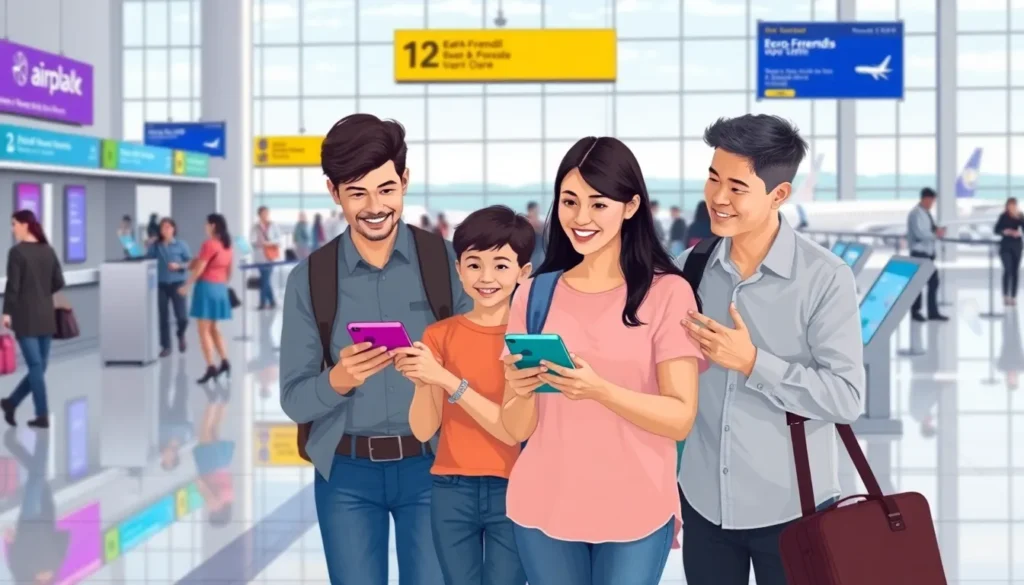The airline industry is soaring to new heights, and it’s not just because of those fancy jet engines. With travel making a comeback, airlines are embracing innovative trends that promise to transform the way people fly. From high-tech check-ins that make waiting in line feel like a thing of the past to eco-friendly practices that would make Mother Nature proud, the skies are buzzing with change.
As travelers become more discerning, airlines are stepping up their game. Think more legroom, gourmet meals that don’t taste like cardboard, and in-flight entertainment that could rival a Netflix binge. Buckle up as we explore the latest trends that are reshaping air travel and making flying a bit more enjoyable—because let’s face it, who wouldn’t want to trade cramped seats for a little luxury in the clouds?
Trends in Airline Industry
Airlines are increasingly adopting technology to streamline operations. Self-service kiosks and mobile applications facilitate check-ins and allow passengers to manage bookings easily. Automation enhances the efficiency of baggage handling, improving the overall travel experience.
Sustainability practices gain traction as airlines implement eco-friendly measures. Many companies commit to reducing carbon emissions, with some aiming for net-zero emissions by 2050. Use of sustainable aviation fuel grows, as does investment in modern, fuel-efficient aircraft.
Passenger preferences drive the change in amenities. Travelers seek comfort and convenience, prompting airlines to expand legroom and upgrade their seating options. Enhanced Wi-Fi connectivity on flights meets the demand for better in-flight entertainment and productivity.
Personalization becomes pivotal for consumer engagement. Airlines use data analytics to tailor offers and services based on individual travel patterns. Loyalty programs now incorporate more rewards, appealing to frequent flyers and encouraging repeat business.
As health and safety remain top priorities, airlines introduce rigorous cleaning protocols. HEPA filters and regular sanitation of aircraft provide peace of mind for travelers. Enhanced boarding procedures ensure social distancing and minimize contact.
Airlines adapt to a rapidly changing landscape through technology, sustainability, and improved customer experience. Each trend reflects a commitment to meeting the evolving expectations of modern travelers while contributing to a safer, more enjoyable journey.
Technological Advancements

Recent technological advancements shape the airline industry, enhancing the flying experience. Innovations are evident across various aspects, from aircraft design to operational efficiency.
Innovations In Aircraft Design
Aircraft design increasingly focuses on fuel efficiency and passenger comfort. New models incorporate lightweight materials that improve aerodynamics. Designs prioritize quieter cabins, which enhance the traveler experience. Jet engines are becoming more efficient, resulting in reduced carbon emissions while maintaining speed. Airlines now select aircraft with better seating configurations and advanced in-flight entertainment systems to cater to passenger preferences. These significant upgrades attract environmentally conscious travelers while optimizing operational costs.
Emerging Technologies For Efficiency
Emerging technologies facilitate enhanced operational efficiency within airlines. Automation streamlines check-in processes, minimizing wait times through self-service kiosks and mobile applications. Predictive maintenance powered by data analytics ensures aircraft remain in optimal condition, reducing unplanned downtime. Baggage handling systems now utilize robotics and tracking technology, improving accuracy and speed in baggage transfers. Moreover, artificial intelligence plays a crucial role in analyzing passenger data, aiding in personalized offers and improved loyalty programs. All these efforts create a smoother travel experience while maximizing airline productivity.
Sustainability Efforts
Sustainability is becoming crucial in the airline industry as companies seek to address environmental concerns. Airlines actively pursue initiatives that minimize their carbon footprint.
Carbon Neutral Goals
Company commitments to carbon neutrality shape airline strategies significantly. Airlines aim for net zero emissions by 2050, with a growing number setting shorter-term targets. Investments in sustainable aviation fuel (SAF) play a major role in achieving these objectives. It’s estimated that SAF can reduce emissions by up to 80% over traditional jet fuel. Collaboration with regulators and manufacturers accelerates the development and deployment of cleaner technologies, enhancing overall efficiency.
Eco-Friendly Initiatives
Airlines implement various eco-friendly initiatives to foster sustainability. Adoption of fuel-efficient aircraft leads to significant reductions in carbon emissions. Many airlines now employ innovative recycling programs that manage waste effectively. Additionally, partnerships with environmental organizations help raise awareness about sustainable travel practices. Electric ground support equipment is increasingly utilized, reducing reliance on fossil fuels at airports. These efforts underscore airlines’ dedication to transforming the industry towards a greener future.
Customer Experience Enhancements
Customer experience plays a crucial role in the evolving airline industry. Airlines focus on personalizing services and utilizing digital platforms to meet travelers’ growing expectations.
Personalization In Services
Data analytics enhances the personalization of airline services. Airlines analyze passenger preferences to create tailored offers, improving customer loyalty. Frequent flyers benefit from loyalty programs that cater to their individual needs, making travel experiences more enjoyable. Custom meal options and dedicated customer support channels further enrich the traveler’s journey. Airlines that invest in personalizing services create deeper connections with their customers, ultimately leading to increased satisfaction and repeat business.
Use Of Digital Platforms
Digital platforms revolutionize the way travelers interact with airlines. Mobile applications streamline check-ins and bookings, enabling passengers to manage their travel effortlessly. Self-service kiosks provide convenient options for quick check-ins and baggage drops. Enhanced Wi-Fi connectivity during flights allows passengers to stay connected and access in-flight entertainment. Integration of chatbots offers 24/7 customer support, addressing inquiries instantly. Airlines leveraging digital solutions improve efficiency, driving higher customer satisfaction and engagement as they navigate the complexities of modern travel.
Economic Factors Influencing Trends
Economic dynamics play a vital role in shaping trends within the airline industry. Key considerations range from fluctuating fuel prices to the recovery trajectory following the pandemic.
Fuel Prices And Their Impact
Fuel prices significantly influence operational costs for airlines. When prices rise, airlines face increased expenses, often leading to higher ticket prices for travelers. Conversely, low fuel costs enhance profit margins, allowing airlines to invest in improvements. In January 2023, global crude oil prices averaged $85 per barrel, leading to a 5% increase in ticket prices. This ongoing volatility impacts route planning and overall operational strategies, pushing airlines to adopt fuel-efficient fleets and explore alternative fuels to mitigate risks associated with price surges.
Recovery Post-Pandemic
The airline industry continues to rebound from the pandemic’s impact. In 2023, passenger volumes neared pre-pandemic levels, with a 40% increase in air travel compared to the previous year. This resurgence has prompted airlines to rethink their business models, focusing heavily on flexibility and customer service. Increased demand for leisure travel drives airlines to introduce new routes and expand existing networks. Additionally, maintaining higher health and safety standards is crucial as consumer confidence rebuilds. Overall, the rebound highlights the importance of adaptability in the evolving market landscape, emphasizing a commitment to meeting current traveler expectations.
Conclusion
The airline industry is undergoing a significant transformation driven by technological advancements and a strong focus on sustainability. As airlines adapt to the evolving needs of travelers they’re prioritizing enhanced customer experiences and eco-friendly practices. Innovations in technology streamline operations while improving passenger comfort and personalization.
This commitment to sustainability and customer satisfaction is reshaping the future of air travel. With a growing emphasis on reducing carbon footprints and enhancing service quality airlines are not just responding to market demands but are also setting new standards for the industry. The future looks promising as airlines continue to innovate and evolve in response to the changing landscape of travel.



